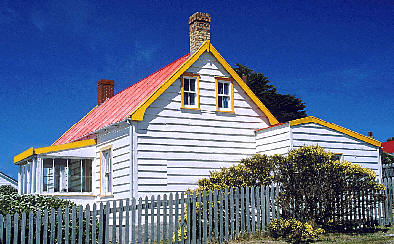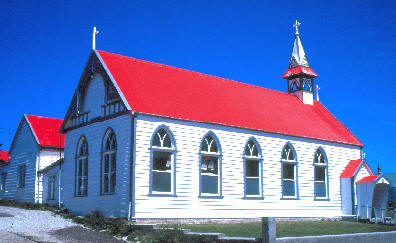福克兰群岛

Table of contents
福克兰群岛是一个位于南大西洋的群岛,由大约700个岛屿组成,最大的是东福克兰和西福克兰。 它们位于合恩角东北约770公里(480英里),距离南美大陆最近的地方有480公里(300英里)。 福克兰群岛是英国的一个充满活力的海外领土,正成为一个越来越受欢迎的旅游目的地。
 1592年,英国航海家约翰-戴维斯船长乘坐 "渴望 "号帆船首次看到该群岛(该船的名字已被纳入福克兰群岛徽章上的格言 "渴望权利")。 1690年,约翰-斯特朗船长在福克兰群岛上首次有登陆记录。
1592年,英国航海家约翰-戴维斯船长乘坐 "渴望 "号帆船首次看到该群岛(该船的名字已被纳入福克兰群岛徽章上的格言 "渴望权利")。 1690年,约翰-斯特朗船长在福克兰群岛上首次有登陆记录。
群岛的土地总面积为4700平方英里,超过威尔士面积的一半,常住人口为2931人(2001年人口普查)。 首都斯坦利(2001年人口为1981人)是唯一的城镇。 在坎普(当地对农村的称呼)的其他地方,有许多较小的定居点。 英语是国家语言,99%的人口将英语作为其母语。舌头。 人口几乎完全是英国人的出生或后裔,许多家庭在群岛的起源可以追溯到1833年后的早期定居者。
传统建筑
在风景中脱颖而出,用铁板或木质防雨板包覆的木结构房屋,白色的墙壁,彩色的屋顶和油漆木制品在阳光下闪闪发光,是福克兰群岛的特色。
岛上古建筑的独特魅力来自于开拓者们的传统。 他们不仅要克服与世隔绝的困难,还要克服无树的地貌,不容易得到其他材料的庇护。 一位18世纪的本笃会牧师首先发现,当地盛行的石头不可能被用于建筑。 当他到达1764年,法国人Dom Pernety与布干维尔的队伍一起旅行,他写道:"我试图在其中一块石头上刻上名字,但这是徒劳的,我的刀和冲子都无法在上面留下任何印象。"
See_also: 达内罗的五个区
后代的定居者与不屈不挠的石英岩作斗争,缺乏天然石灰也阻碍了石头建筑。 最后,它通常只用于地基,尽管一些先驱者纯粹的毅力为我们留下了少数美丽、坚固的石头建筑,如1854年的乌兰雁酒店。
由于石头很难使用,而且没有树木,所以除了进口建筑材料外别无选择。 他们选择了最便宜和最轻的木材和锡,因为定居者并不富裕,所有的东西都必须跨越暴风雨的海洋运输数百英里。 岛上的所有主要定居点都建在天然港口,因为大海是唯一的公路。任何在陆地上移动的东西都必须由拉着木制雪橇的马匹痛苦地拖过崎岖不平的乡村。 木材和铁比石头更有优势,因为可以快速建造建筑物,而且不需要特殊技能。 早期的定居者不得不住在船舱里或最粗糙的棚屋里,同时建造他们的房屋。
19世纪40年代初,由于海军的原因,首都从路易港迁至威廉港。 在以当时的殖民地秘书命名的新生定居点斯坦利,甚至连殖民地外科医生都住在花园里的帐篷里,而他的房子,斯坦利小屋,今天是教育部的办公室。 总督理查德-克莱门特-穆迪将他的新城镇建在了罗斯路(Ross Road)是以詹姆斯-克拉克-罗斯爵士(Sir James Clark Ross)的名字命名的,他是决定新首都选址的海军指挥官;菲茨罗伊路(Fitzroy Road)是以罗伯特-菲茨罗伊船长(Robert Fitzroy)的名字命名的,他是1833年将查尔斯-达尔文带到福克兰群岛的贝格尔号调查船的指挥官。

建筑物有时是以成套的形式从英国运来的,以方便建造。 斯坦利的例子包括会堂和圣玛丽教堂,都是19世纪末建造的。 但为了节省时间和金钱,岛民们开始善于使用手头的任何材料。
See_also: 东印度公司及其在统治印度方面的作用事实证明,大海是一个丰富的宝库。 在1914年巴拿马运河开通之前,合恩角是世界上最伟大的贸易路线之一。 但许多帆船在暴风雨的水域中遭遇不幸,在福克兰群岛结束了它们的生命。 它们的遗产在老建筑中继续存在,在那里可以找到桅杆和船坞的部分作为基础桩和地板托架。 沉重的帆布船帆、在与南方海洋的斗争中,甲板上的木板被打上了补丁和破损,光秃秃的木板被衬托着。 甲板为鸡提供了庇护,天窗被用作花园的冷柜。 没有任何东西被浪费掉。
因此,福克兰群岛的典型建筑是简单的木结构建筑,有波纹铁皮屋顶,简易的绝缘材料,墙壁上覆盖着平坦的锡板或木制防雨板。 油漆最初是用来保护木材和铁皮免受大西洋咸空气的影响。 它成为一种备受喜爱的装饰形式。 近年来,福克兰群岛发生了许多变化,但建筑物中的色彩传统继续为景观注入活力和特色。
作者:简-卡梅伦。
基本信息
完整的国家名称: 福克兰群岛
地区: 2,173平方公里
资本 城市: 斯坦利
宗教信仰(S): 基督教,斯坦利有天主教、英国圣公会和联合改革教会。 其他基督教教会也有代表。
状态: 英国海外领土
人口: 2,913 ( 2001年人口普查)
语言: 英语
货币: 福克兰群岛镑(与英镑平价)
总督: 霍华德-皮尔斯先生阁下,CVO

